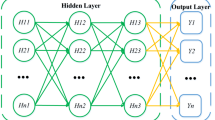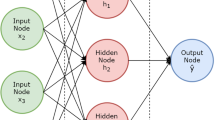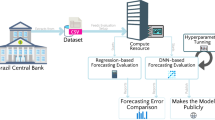Abstract
Exchange rate forecasting has always been a research hot spot of international finance studies. Deep belief network (DBN) model of deep learning is a new method of predicting the exchange rate data, and the designing of DBN structure and the learning rules of parameters are the most important parts of DBN model. The paper firstly divides the time series data into training and testing sets. By optimizing the DBN parameters, the paper analyses the results of the training analysis and answers how to do node setting. Then, the paper adjusts the number of hidden nodes, inputs nodes and hidden layers, and by using multiple variance analysis, it determines the sensitive range of the node. Finally, the experiments of INR/USD and CNY/USD have proved that compared with the FFNN model, the improved DBN model could better forecast the exchange rate.







Similar content being viewed by others
References
Zhang G, Hu MY (1998) Neural network forecasting of the British pound/US dollar exchange rate. Omega 26(4):495–506
Zhang R, Shen F, Zhao J (2014) A model with fuzzy granulation and deep belief networks for exchange rate forecasting. In: International joint conference on neural networks, pp 366–373
LeCun Y, Bengio Y, Hinton G (2015) Deep learning. Nature 521(7553):436–444
Schmidhuber J (2015) Deep learning in neural networks: an overview. Neural Netw 61:85–117
Hinton GE, Osindero S, Teh YW (2006) A fast learning algorithm for deep belief nets. Neural Comput 18:1527–1554
Hinton GE, Salakhutdinov RR (2008) Using deep belief nets to learn covariance kernels for Gaussian processes. In: Advances in neural information processing systems, pp 1249–1256
Kuremotoa T, Kimuraa S, Kobayashib K, Obayashia M (2014) Time series forecasting using a deep belief network with restricted Boltzmann machines. Neurocomputing 137(15):47–56
Shen F, Chao J, Zhao J (2015) Forecasting exchange rate using deep belief networks and conjugate gradient method. Neurocomputing 167(C):243–253
Chen H, Murray AF (2003) Continuous restricted Boltzmann machine with an implementable training algorithm. IEE Proc Vis Image Signal Process 150(3):153–158
Minsky M, Papert S (1988) Perceptrons, vol 84(1). MIT Press, Cambridge, pp 449–452
Erhan D, Manzagol PA, Bengio Y, Bengio S, Vincent P (2009) The difficulty of training deep architectures and the effect of unsupervised pre-training. In: Immunology of fungal infections, vol 5, pp 153–160
Erhan D, Bengio Y, Courville A, Manzagol PA, Vincent P (2010) Why does unsupervised pre-training help deep learning? J Mach Learn Res 11:625–660
Hinton GE, Dayan P, Frey BJ (1995) The “wake–sleep” algorithm for unsupervised neural networks. Science 268(5214):1158–1161
Hinton GE (2002) Training products of experts by minimizing contrastive divergence. Neural Comput 14(8):1771–1800
Ma X, Wang X (2016) Average contrastive divergence for training restricted Boltzmann machines. Entropy 18(1):35
Chen H, Murray A (2002) A continuous restricted Boltzmann machine with a hardware-amenable learning algorithm. In: Artificial neural networks—ICANN 2002, pp 358–363
Frey BJ (1997) Continuous sigmoidal belief networks trained using slice sampling. In: Advances in neural information processing systems, pp 452–458
Khashei M, Bijari M, Ardali GAR (2009) Improvement of auto-regressive integrated moving average models using fuzzy logic and artificial neural networks. Neurocomputing 72(4):956–967
Dhamija AK, Bhalla VK (2011) Exchange rate forecasting: comparison of various architectures of neural networks. Neural Comput Appl 20(3):355–363
Kodogiannis V, Lolis A (2002) Forecasting financial time series using neural network and fuzzy system-based techniques. Neural Comput Appl 11(2):90–102
Author information
Authors and Affiliations
Corresponding author
Ethics declarations
Conflict of interest
The authors declared that they have no conflicts of interest to this work. We declare that we do not have any commercial or associative interest that represents a conflict of interest in connection with the work submitted. This work was supported in part by the Scientific Research Starting Foundation of Hangzhou Dianzi University (No. KYS395617020). The author Fu X. also works in the Research Center of Information Technology & Economic and Social Development.
Rights and permissions
About this article
Cite this article
Zheng, J., Fu, X. & Zhang, G. Research on exchange rate forecasting based on deep belief network. Neural Comput & Applic 31 (Suppl 1), 573–582 (2019). https://doi.org/10.1007/s00521-017-3039-z
Received:
Accepted:
Published:
Issue Date:
DOI: https://doi.org/10.1007/s00521-017-3039-z




